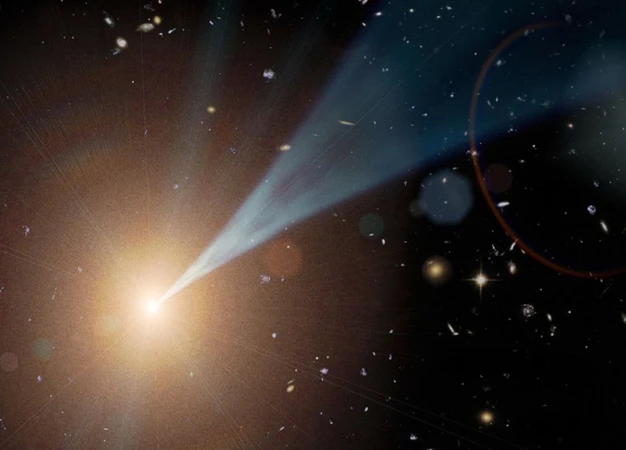Unveiling the Unfathomable: Black Hole Jets
Welcome to the mind-boggling world of black hole jets, where perplexity meets fascination. In this captivating article, we will delve deep into the enigmatic phenomenon of black hole jets and explore the intriguing mechanisms behind their formation and behavior. Brace yourself for an extraordinary journey through the cosmos as we unravel the mysteries of these powerful beams of energy that emanate from the depths of black holes. Get ready to embark on a compelling expedition, as we shed light on the cosmic spectacle of black hole jets.
Contents
- What are Black Hole Jets?
- The Role of Accretion Disks
- The Powerful Mechanisms Behind Black Hole Jets
- Observing Black Hole Jets
- Black Hole Jets and Galactic Evolution
- Implications for the Universe
- Conclusion
-
Frequently Asked Questions
- 1. How are black hole jets formed?
- 2. What is the structure of black hole jets?
- 3. How fast do black hole jets travel?
- 4. Do black hole jets always point in the same direction?
- 5. Can black hole jets be observed from Earth?
- 6. What role do magnetic fields play in black hole jets?
- 7. Could black hole jets pose a threat to Earth?
- 8. How do black hole jets impact galactic evolution?
- 9. Is there a relationship between black hole jets and the zodiac signs?
- 10. What are the implications of black hole jets for our understanding of the universe?
- References
-
Frequently Asked Questions
- 1. How are black hole jets formed?
- 2. What are the characteristics of black hole jets?
- 3. What is the structure of black hole jets?
- 4. In what direction do black hole jets travel?
- 5. What is the role of accretion disks in the formation of black hole jets?
- 6. How do magnetic fields contribute to black hole jets?
- 7. How are particles accelerated within black hole jets?
- 8. What is broadband emission in relation to black hole jets?
- 9. How do scientists observe black hole jets?
- 10. What are the implications of black hole jets for the universe?
- References
- Read More
What are Black Hole Jets?
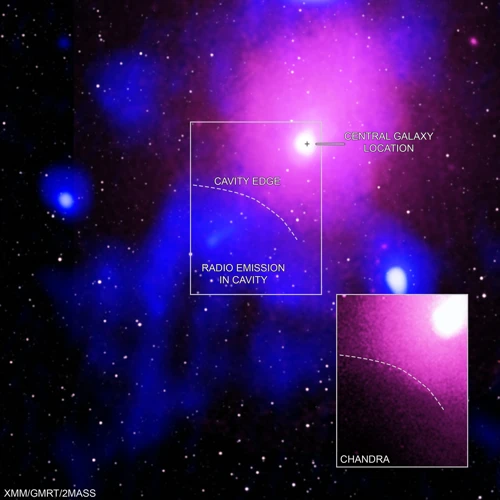
What are Black Hole Jets?
Black hole jets are mesmerizing phenomena that leave us in awe and wonder. These captivating cosmic discharges are powerful beams of energy that shoot out from the vicinity of supermassive black holes. But how do these extraordinary jets come into existence? The answer lies in the complex interplay of various cosmic forces and phenomena. The formation of black hole jets involves the intricate dynamics of accretion discs and intense magnetic fields, which we will explore in more detail. The characteristics of these jets, such as their structure, speed, and direction, add to their mystique. Let’s untangle the enigma and delve deeper into the extraordinary world of black hole jets.
1. Formation of Black Hole Jets
The formation of black hole jets is a mesmerizing cosmic dance that takes place in the vicinity of supermassive black holes. It all begins with an accretion disk, a swirling disk of gas and dust that surrounds the black hole. As matter falls into the gravitational pull of the black hole, it spirals inward, gaining tremendous speed and energy. This process releases an enormous amount of gravitational potential energy, resulting in the formation of powerful jets. The exact mechanisms behind jet formation are not yet fully understood, but it is believed that magnetic fields play a crucial role in channeling and focusing the released energy into narrow, high-speed jets. These jets extend thousands of light-years into space, defying comprehension and leaving scientists in awe of their grandeur. To truly grasp the complexity of black hole jet formation, one must venture into the depths of cosmic phenomena and witness the intertwining forces at play.
2. Characteristics of Black Hole Jets
Characteristics of Black Hole Jets
When it comes to black hole jets, their characteristics are nothing short of remarkable. These cosmic marvels exhibit a variety of fascinating traits that captivate astronomers and physicists alike. One prominent characteristic is their immense power. Black hole jets unleash an astonishing amount of energy, often surpassing the energy output of entire galaxies. These jets can extend over vast distances, spanning millions of light-years, showcasing their colossal scale. Black hole jets exhibit collimation, meaning they maintain a narrow focus over long distances, staying confined to a tight beam rather than dispersing. The emissions from these jets span a wide range of wavelengths, from radio waves to gamma rays, making them a prime object of study across the electromagnetic spectrum. As we continue our exploration, we will uncover even more intriguing features of these enigmatic cosmic phenomena.
3. Structure of Black Hole Jets
3. Structure of Black Hole Jets
The structure of black hole jets is a captivating aspect that adds to their awe-inspiring nature. These jets exhibit a hierarchical arrangement comprised of different components. At the heart of the jet lies the core, where the black hole’s immense gravity pulls matter inward. Surrounding the core is the inner jet, which consists of highly energized particles propelled by strong magnetic fields. As the jet extends outward, it expands into the outer jet region, where particles continue to gain speed and emit intense radiation. The outer jet can stretch vast distances away from the black hole, sometimes even exceeding thousands of light-years. The structure of black hole jets can be intricate and dynamic, with various regions exhibiting diverse physical properties. This complexity contributes to the mesmerizing nature of these cosmic phenomena and continues to fascinate astronomers and astrophysicists who explore their depths.
4. Speed and Direction of Black Hole Jets
One of the intriguing aspects of black hole jets is their incredible speed and direction. These jets can reach velocities close to the speed of light, making them some of the fastest phenomena in the universe. The exact mechanisms behind this high-speed motion are still the subject of ongoing research and exploration.
The direction of black hole jets primarily depends on the orientation of the black hole’s spin axis and the orientation of its accretion disc. As matter falls toward the black hole, it forms an accretion disc around it. The intense gravitational and magnetic forces in this disc contribute to the creation of the jets. The orientation of the jets is aligned with the rotational axis of the black hole and the direction of its magnetic field lines.
It’s important to note that black hole jets can exhibit a phenomenon known as precession, where the direction of the jets changes over time due to the spinning of the black hole. This precession can result in the formation of complex and beautiful structures as the jets interact with their surrounding environment.
Understanding the speed and direction of black hole jets provides insights into the underlying physical processes at work. Scientists study these phenomena to gain a deeper understanding of the powerful forces and dynamics of black holes. Through meticulous observations and detailed simulations, researchers continue to unravel the mysteries surrounding the mesmerizing motion of black hole jets.
To learn more about the elements and their significance in astrology, you can explore our article on Understanding the Elements in Zodiac Signs.
The Role of Accretion Disks
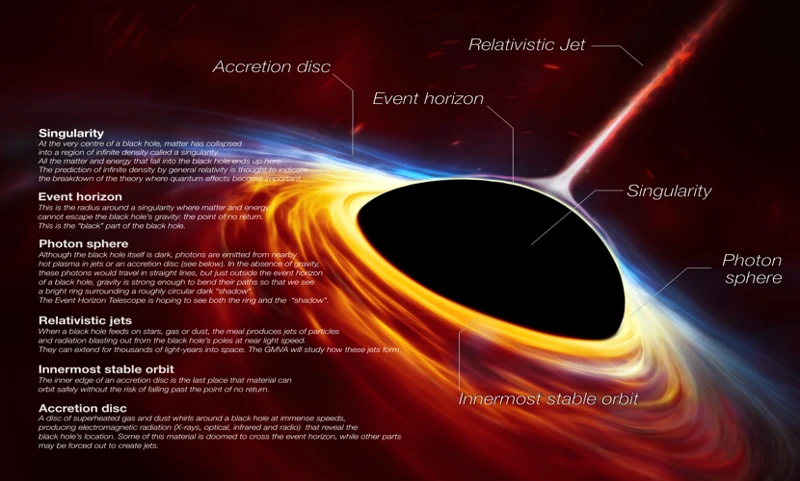
The Role of Accretion Disks
Accretion disks play a pivotal role in the formation and sustenance of black hole jets. These disks are swirling concentrations of cosmic material, including gas, dust, and even stars, that orbit around black holes. As this matter spirals towards the black hole, it forms a disk due to the conservation of angular momentum. The intense gravitational pull of the black hole heats up this disk, resulting in immense temperatures and pressure. This process, known as accretion, releases an enormous amount of energy in the form of radiation. The energy released from the accretion disk powers the black hole jets, propelling them outward into space at tremendous velocities.
It is interesting to note that the accretion disk is not uniform in its composition or temperature. It consists of distinct regions such as the innermost region called the “hot corona” and the outer region called the “thin disk.” The hot corona is an extremely hot and turbulent region where high-energy particles, generated due to magnetic reconnection events, are present. These energetic particles are thought to play a crucial role in accelerating charged particles along magnetic field lines, ultimately contributing to the formation of the powerful jets.
The complex dynamics of the accretion disk and its interaction with the black hole’s gravitational pull create the perfect conditions for the generation of black hole jets. Understanding the mechanisms at play within these accretion disks is key to unraveling the mysteries surrounding these fascinating cosmic phenomena.
(Reference: Epic of Gilgamesh: Exploring the Oldest Surviving Mesopotamian Mythology)
The Powerful Mechanisms Behind Black Hole Jets
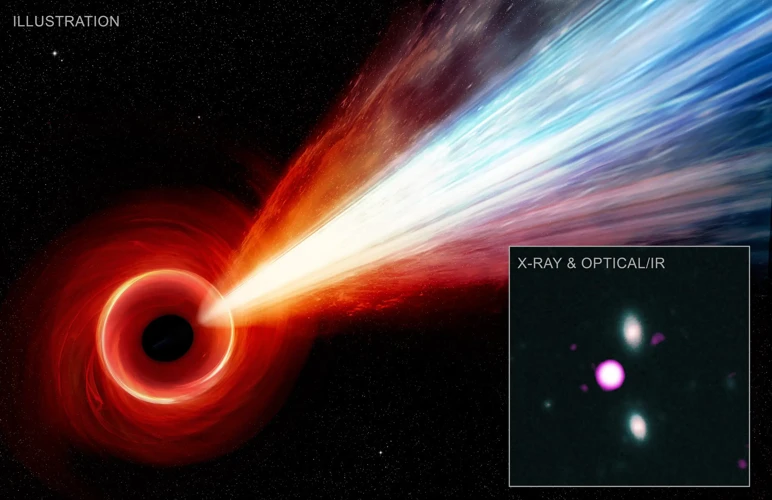
The powerful mechanisms behind black hole jets are a testament to the awe-inspiring scale of cosmic phenomena. These jets are propelled by a series of intricately interconnected processes that involve magnetic fields, particle acceleration, and broadband emission. The first key component, magnetic fields, plays a significant role in shaping and channeling the high-energy particles along focused paths, ultimately giving rise to the spectacular jets. As particles gain energy through a process known as particle acceleration, they speed up, creating a torrent of energetic particles that contribute to the powerful emission of radiation across a wide range of wavelengths, known as broadband emission. This process is essential for understanding the complex dynamics and intricate interplay that govern the remarkable phenomenon of black hole jets. Embark on a journey of cosmic wonder as we uncover the mesmerizing world of black hole jets and the mechanisms that propel them forward, shaping our understanding of the vast universe we inhabit.
1. Magnetic Fields
1. Magnetic Fields
One of the key players in the mesmerizing phenomenon of black hole jets is the magnetic field. The intense magnetic fields surrounding black holes play a crucial role in shaping and launching these powerful streams of energy. But how does this magnetic field become so influential? It all begins with the presence of an accretion disk, a swirling disk of material that surrounds the black hole. As matter falls towards the black hole, the magnetic field lines become twisted and distorted. This distortion creates immense energy, causing particles to accelerate along the magnetic field lines. These accelerated particles then get flung outwards in the form of jets, propelled by the strong magnetic forces. The exact mechanisms behind this process are still not fully understood, adding to the intrigue of black hole jets. The study of magnetic fields and their interaction with black holes continues to shed light on the nature of these awe-inspiring cosmic phenomena.
2. Particle Acceleration
2. Particle Acceleration
One of the key mechanisms behind the creation of black hole jets is particle acceleration. Within the intense gravitational pull near the black hole, particles are accelerated to incredible speeds, approaching the speed of light. As these charged particles swirl around the vicinity of the event horizon, they interact with the strong magnetic fields present. Through a process known as magnetic reconnection, some of the particles become energized, gaining significant amounts of kinetic energy. This acceleration process transforms ordinary particles into highly energetic ones, contributing to the powerful jets emitted from black holes. The phenomenon of particle acceleration is a crucial component in understanding the dynamics and immense energy release associated with black hole jets. To delve deeper into the mysteries of cosmic phenomena, such as black holes and their influence on astrology, you can explore the symbolic meaning of the Ophiuchus symbol in the Zodiac.
3. Broadband Emission
Broadband emission is a fascinating aspect of black hole jets that adds to the complexity and intrigue of these cosmic phenomena. When we talk about broadband emission, we are referring to the wide range of electromagnetic radiation that black hole jets emit across different wavelengths. This diverse emission spans from radio waves to gamma rays, covering a vast spectrum of frequencies.
One of the key factors behind broadband emission in black hole jets is the high-speed motion of charged particles within the jets. As these particles travel at incredible velocities, they emit radiation at various wavelengths, creating a diverse range of emissions.
To better understand the concept of broadband emission, let’s break it down into its different components:
1. Radio Emission: At the lower end of the electromagnetic spectrum, black hole jets emit radio waves. These long wavelength radio emissions can be detected and observed using radio telescopes.
2. Optical and X-ray Emission: Moving higher up the spectrum, black hole jets produce emissions in the optical and X-ray wavelengths. These emissions provide valuable insights into the physical processes occurring within the jets.
3. Gamma Ray Emission: At the highest end of the spectrum, black hole jets emit gamma rays. These extremely high-energy photons carry valuable information about the particles and processes involved in the jet dynamics.
The ability to observe and study broadband emission from black hole jets provides scientists with crucial data to understand the mechanisms and physics behind these mesmerizing phenomena. By analyzing the different wavelengths of radiation emitted by black hole jets, astronomers can gain insights into the composition, velocity, and behavior of the particles within the jets.
Black hole jets continue to intrigue and perplex researchers as they strive to unravel the mysteries surrounding these cosmic spectacles. Broadband emission remains a captivating aspect of black hole jets, offering a window into the intricate dynamics and phenomena at play within these enigmatic jets.
Observing Black Hole Jets
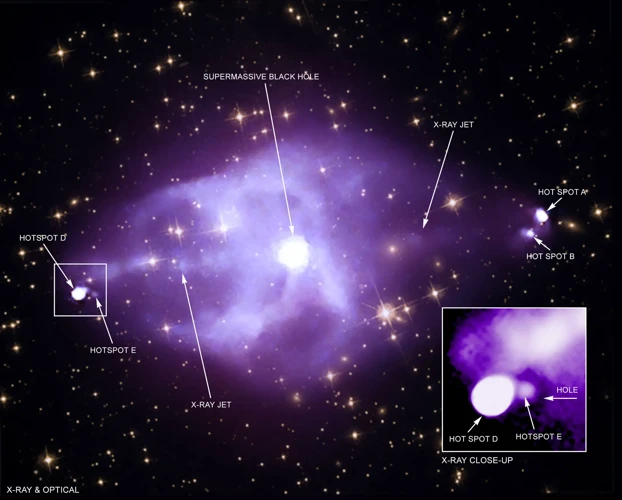
Observing Black Hole Jets
Observing black hole jets is a formidable endeavor that requires advanced astronomical techniques and instruments. Scientists employ a variety of methods to study these fascinating phenomena and gain insights into their nature. Here are some key approaches utilized in the observation of black hole jets:
1. Radio Observations: Radio telescopes play a pivotal role in detecting and analyzing black hole jets. These telescopes capture emissions in the radio frequency range, allowing scientists to observe the radio waves emitted by the jets. By studying the intensity, polarization, and spectral characteristics of these radio emissions, researchers can decipher valuable information about the jets’ properties.
2. X-ray and Gamma-ray Observations: Black hole jets can emit high-energy X-rays and gamma-rays. Satellites equipped with X-ray and gamma-ray detectors, such as NASA’s Chandra X-ray Observatory and Fermi Gamma-ray Space Telescope, are used to observe these emissions. These observations provide crucial data about the particles and processes involved in jet formation.
3. Multi-wavelength Studies: To obtain a comprehensive understanding of black hole jets, scientists employ multi-wavelength observations. By combining data from various sources, including radio, optical, X-ray, and gamma-ray observations, researchers can gather a more complete picture of the jets’ behavior and evolution.
4. Time-domain Observations: Black hole jets are dynamic phenomena, with their behavior changing over time. Continuous monitoring of these jets is vital to capture their transient events and study their variability. Time-domain observations, using telescopes capable of capturing rapid changes in the jet emissions, help unravel the dynamic nature of these cosmic marvels.
Through these observation techniques and the collaborative efforts of scientists worldwide, our understanding of black hole jets continues to expand. These observations not only deepen our knowledge of these bewildering phenomena but also provide crucial insights into the larger picture of galactic evolution and the Universe as a whole.
Black Hole Jets and Galactic Evolution
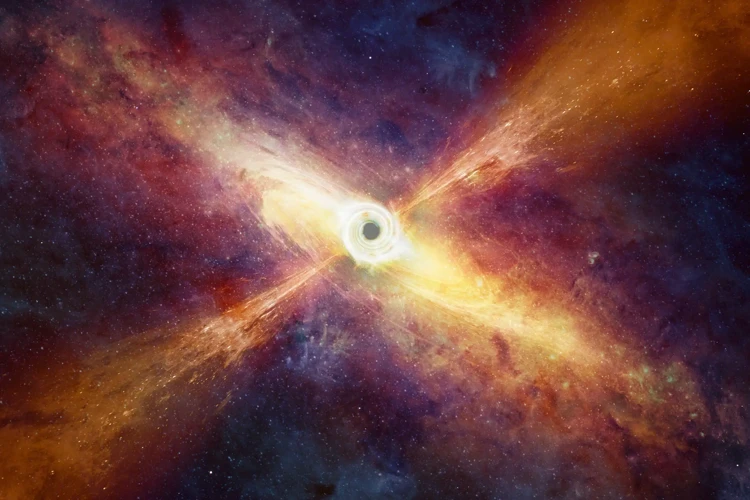
Black Hole Jets and Galactic Evolution
Black hole jets have a profound impact on the evolution of galaxies, playing a crucial role in shaping their destiny. These energetic jets inject vast amounts of energy into their host galaxies, influencing their structure, composition, and overall dynamics. As the powerful jets blast through the galaxy, they interact with the surrounding interstellar medium, triggering a cascade of events. The energy imparted by the jets can compress the interstellar gas, leading to the formation of new stars. Additionally, the jets stir up the interstellar medium, enhancing turbulence and mixing elements throughout the galaxy. This cosmic choreography of black hole jets and galactic evolution is a dance of energy and matter, sculpting the galaxies we see today. Understanding the intricate relationship between black hole jets and galactic evolution is key to unraveling the mysteries of the cosmos and our place within it.
Implications for the Universe
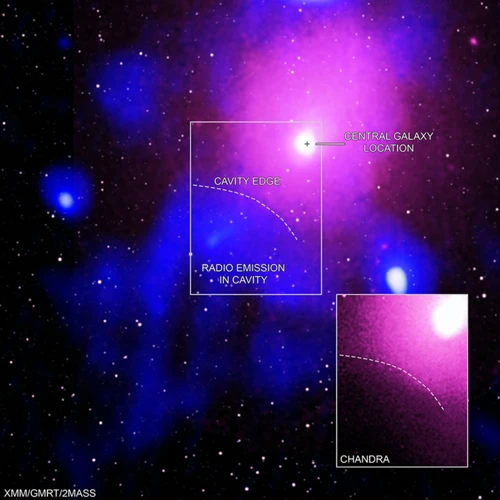
Implications for the Universe
The existence and behavior of black hole jets have profound implications for our understanding of the universe. These cosmic spectacles serve as windows into the extreme environments surrounding supermassive black holes, which are believed to reside at the center of many galaxies. The powerful mechanisms behind black hole jets, such as magnetic fields and particle acceleration, offer insights into the complex interplay of forces in these cosmic powerhouses.
1. Galactic Evolution: Black hole jets play a crucial role in galactic evolution. These jets can transport vast amounts of energy and matter across enormous distances, potentially influencing the formation of stars, the growth of galaxies, and the regulation of the interstellar medium. By understanding the impact of black hole jets, scientists can gain a deeper understanding of how galaxies evolve over time.
2. Quenching Star Formation: The energy released through black hole jets can have a significant impact on star formation within galaxies. The intense radiation and shockwaves produced by these jets can compress gas clouds, triggering the collapse and formation of new stars in some regions while inhibiting star formation in others. This delicate balance between black holes and star formation shapes the overall structure and dynamics of galaxies.
3. Feedback Mechanism: Black hole jets are thought to play a key role in regulating the growth of supermassive black holes themselves. The energy released through the jets can exert a powerful “feedback” effect on the surrounding gas, preventing further accretion onto the black hole. This feedback mechanism helps maintain a balance between the growth of black holes and the supply of matter from their surroundings.
4. Unveiling Fundamental Physics: Studying black hole jets provides valuable insights into the fundamental physics operating in extreme environments. The intricate interplay between magnetic fields, particle acceleration, and radiation processes can help scientists refine their understanding of general relativity, plasma physics, and the behavior of matter under extreme conditions.
As we continue to explore and unravel the mysteries of black hole jets, we deepen our knowledge of the universe and enhance our understanding of the cosmic ballet unfolding before our eyes. These mesmerizing phenomena not only captivate our imagination but also have far-reaching implications for the dynamics and evolution of the cosmos we call home.
Conclusion

Infinite Wonders Await: Concluding the Journey
The voyage through the captivating world of black hole jets has come to a close, but the mysteries that surround these cosmic marvels continue to captivate and intrigue us. Through exploring the formation, characteristics, and mechanisms behind black hole jets, we have gained a deeper understanding of these fascinating phenomena. The role of accretion discs and the powerful mechanisms of magnetic fields, particle acceleration, and broadband emission have shed light on the intricate processes that give rise to these awe-inspiring jets. Observations of black hole jets provide valuable insights into galactic evolution and offer implications for the vast mysteries of the universe. As we conclude this journey, we are left in awe of the vast expanse and infinite wonders that await our exploration. The enigma of black hole jets beckons us to embark on countless new adventures, further delving into the depths of the cosmos and uncovering the remarkable secrets that lie within.
Frequently Asked Questions

1. How are black hole jets formed?
Black hole jets are formed through a process known as accretion. Matter from a surrounding disk known as an accretion disk spirals inward towards the black hole, creating intense rotational energy. This energy is then converted into powerful jets that shoot out from the black hole’s poles.
2. What is the structure of black hole jets?
Black hole jets have a complex structure consisting of multiple components. At the core, there is a highly energetic and concentrated plasma beam that is surrounded by various layers of gas, dust, and magnetic fields. This layered structure contributes to the intricate behavior and emission patterns observed in black hole jets.
3. How fast do black hole jets travel?
Black hole jets can travel at incredibly high speeds, often reaching velocities close to the speed of light. The exact speed varies depending on the specific black hole and its surroundings, but these jets can extend over vast distances, spanning thousands of light-years.
4. Do black hole jets always point in the same direction?
No, black hole jets do not always point in the same direction. The orientation and alignment of the jets can change over time due to various factors, such as the rotation of the black hole and the influence of surrounding matter and magnetic fields.
5. Can black hole jets be observed from Earth?
Yes, black hole jets can be observed from Earth using a variety of astronomical instruments. Scientists rely on telescopes that can detect different forms of electromagnetic radiation, including radio waves, X-rays, and gamma rays, to study and analyze these jets.
6. What role do magnetic fields play in black hole jets?
Magnetic fields play a crucial role in the formation and behavior of black hole jets. They help channel and focus the energy and matter flowing towards the black hole, ultimately giving rise to the powerful, narrow beams that characterize these jets.
7. Could black hole jets pose a threat to Earth?
Black hole jets, despite their immense power, pose no direct threat to Earth. The jets remain confined within the vicinity of the black hole, and any distance they travel is on astronomical scales. They do, however, provide valuable insights into the fundamental mechanics of the universe.
8. How do black hole jets impact galactic evolution?
Black hole jets can have a profound influence on galactic evolution. The energy and matter expelled by these jets can impact the surrounding interstellar medium, compressing gas and triggering star formation. They also help regulate the growth and size of galaxies by expelling material that could otherwise lead to excessive growth of central black holes.
9. Is there a relationship between black hole jets and the zodiac signs?
No, there is no direct relationship between black hole jets and the zodiac signs. The zodiac signs are a human construct based on the position of the Sun at the time of an individual’s birth. They hold no scientific correlation with cosmic phenomena such as black hole jets.
10. What are the implications of black hole jets for our understanding of the universe?
Black hole jets provide crucial insights into the fundamental processes occurring in the universe. They help scientists study the behavior of matter in extreme conditions and understand the dynamics of black hole formation, growth, and interaction with their surroundings. By unraveling the mysteries of black hole jets, we gain a deeper understanding of the vast cosmic landscape we inhabit.
References
Frequently Asked Questions

1. How are black hole jets formed?
Black hole jets are formed through a process called accretion, where matter spirals into the black hole and releases a tremendous amount of energy in the form of jets.
2. What are the characteristics of black hole jets?
Black hole jets can travel at incredibly high speeds, sometimes close to the speed of light. They are also incredibly powerful and can expel vast amounts of energy.
3. What is the structure of black hole jets?
Black hole jets consist of a narrow, highly collimated beam of particles and radiation that is emitted from the vicinity of the black hole’s event horizon.
4. In what direction do black hole jets travel?
Black hole jets can travel in any direction, depending on the orientation of the black hole’s spin axis.
5. What is the role of accretion disks in the formation of black hole jets?
Accretion disks play a crucial role in the formation of black hole jets. They are disk-shaped structures of hot, ionized gas that surround the black hole and provide the fuel for the jets.
6. How do magnetic fields contribute to black hole jets?
Magnetic fields play a key role in the generation and collimation of black hole jets. They help to focus and accelerate the particles within the jets, shaping their structure.
7. How are particles accelerated within black hole jets?
Particle acceleration in black hole jets is thought to occur through a combination of mechanisms, including shocks and reconnection of magnetic fields, which can give particles a significant boost in speed.
8. What is broadband emission in relation to black hole jets?
Broadband emission refers to the wide range of electromagnetic radiation emitted by black hole jets, spanning from radio waves to gamma rays. This emission provides valuable insights into the physical processes happening within the jets.
9. How do scientists observe black hole jets?
Scientists observe black hole jets using a variety of telescopes and instruments that are sensitive to different wavelengths of light. This allows them to study the jets at various stages of their evolution.
10. What are the implications of black hole jets for the universe?
Black hole jets are considered to be important drivers of galactic evolution. They can influence star formation, regulate the growth of galaxies, and contribute to the enrichment of interstellar medium.
References
- special relativity – Relativistic Jets in Black Holes
- Black Holes | Center for Astrophysics | Harvard & Smithsonian
- Black Holes

